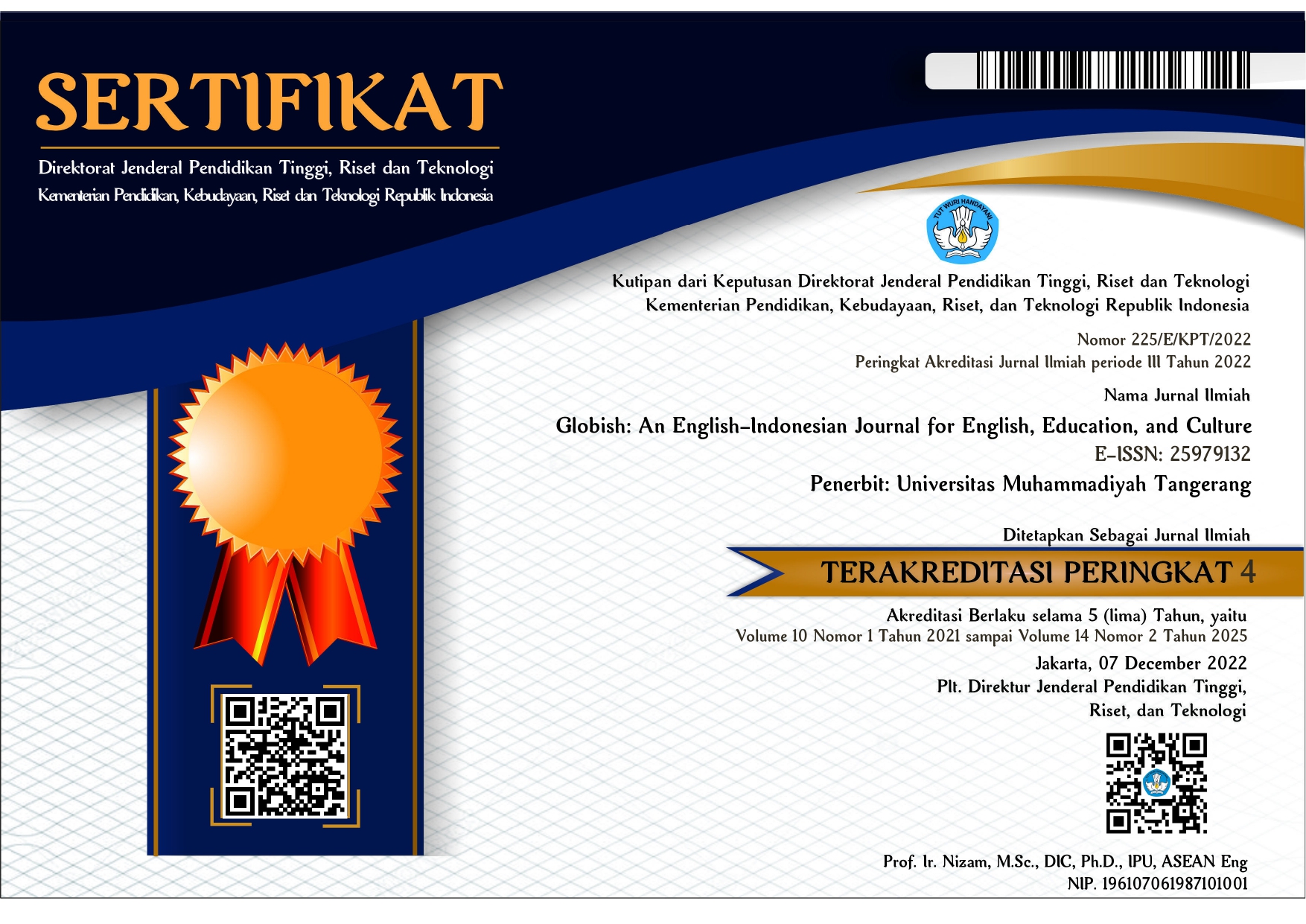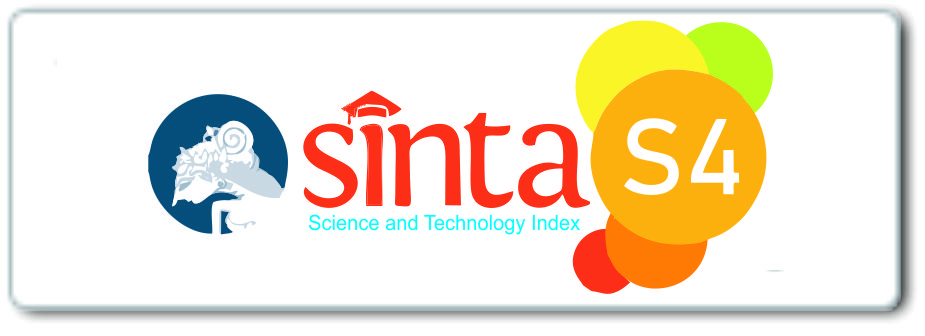THE STUDENS’ DIFFICULTIES IN PRESENTING THE ACADEMIC SPEAKING PRESENTATION
Abstract
Abstract
The aim of the research is to observe the activities of the students in academic speaking classroom, to analyze the student’s problem in presenting the academic speaking presentation and to identify the student’s special needs in academic speaking presentation.The method used in this research is field research that is qualitative, while the analysis of the data used descriptive analysis. The focus of the research is on the student’s difficulties in presenting academic speaking presentation.In sum up, most of the students of English Education Study Program of Teachers Training and Education Faculty of Muhammadiyah University are lack of: 1) Goal setting on their academic speaking presentation, 2) Prioritization on what the essential point need to be presented, 3) Self-awareness on themselves, while they present the presentation in front of the audience, 4) Self-motivation while presenting the materials, it connects with self-awareness; if students have improved their self-awareness so they will have a great deal of the information that they need to motivate themselves. In short, the students need to be able to motivate themselves to take action; 5) Planning, most of students are not planning the materials well so they are not able to manage their time to present the academic presentation; and 6) Communication skill, strong communication skills will enable the students to build supportive relationships with the audience while presenting the materials, in fact not all the students have good communication skill.In short, the student’s preparation well made their presentation is good and it also established good communication between the presenter and the audiences.
Keywords: Academic Speaking, Presentation, Communication
Full Text:
PDFReferences
Alderson, C. J., Wall, D. & C. Claphaim. (1996). Language Test Construction and Evaluation. Cambridge: Cambridge University Press.
Bruner, Jerome. Actual Minds, Possible Worlds. Cambridge, MA: Harvard University Press, 1986.
Brown, D. L. (1996). Kids, computers and constructivism. Journal of Instructional Psychology, 23 (3), 189-196.
Brown, H. D. (1994). Teaching by principles: An interactive approach to language pedagogy. Englewood Cliffs,NJ: Prentice Hall Regents.
Brown, J. S., Collins, A., &Duguid, P. (1989). “Situated cognition and the culture of learning”. Educational Researcher, 18 (1), 32-41. Bippus, A. M. & Daly, J. A. (1999). What do people think causes stage fright? Naïve attributions about the reasons for public speaking. Communication Education, 48, 63-72.
Bruskin Associates. What are Americans afraid of? The Bruskin Report, 1973, 53.
Burns, A., & Joyce, H. (1997). Focus on speaking. Sydney: National Center for English Language Teaching and Research.
Celce-Murcia, M., Brinton, D. & J. Goodwin. (1996). Teaching Pronunciation: a Reference for Teachers of English to Speakers of Other Languages. Cambridge: Cambridge University Press.
Carroll, C. (2005). "Assessing Project-Based Learning: A case study of an undergraduate selling and sales management module at the University of Limerick" in Barrett, T., Mac Labhrainn, I., Fallon, H. (Eds). Handbook of Enquiry and Problem-based Learning
Clement, J. (1993) Using Bridges Analogies and Anchoring Institutions to Deal with Students Preconceptions in Physics. Journal of research in science teaching, vol 30.
Crystal, D. (2003). English as a global language (2nd ed). Cambridge: Cambridge University Press.
Daly, J. A., &McCroskey, J. C. (Eds). (1984). Avoiding communication: Shyness, reticence, and communication apprehension. Newbury Park: Sage.
Dauwalder, D. P. (2000). Formulating sound conclusions and recommendations.The Delta Pi Epsilon Journal 42, 6-13.
Egan, K. (1999). Speaking. A critical skill and a challenge. Calico Journal. 16 No: 3, 277-293.
Gallo, C (2006). The 10 worst presentation habits.BusinessWeek.com. Retrieved October 20, 2006 from: http://images.businessweek.com/ss/06/02/mistakes/index_01.htm
Hoff, E. & Tian, C. (2005). Socioeconomic status and cultural influences on language.Journal of communication Disorders, 38, 271-278.
Jonassen D. H., (1994). Thinking technology: Towards a Constructivist Design Model, Educational Technology, April, 3437
Kim, H. B., Fisher, L. D., & Fraser, J. B. (1999). Assessment and investigation of constructivist science learning environment in Korea.
King, J. (2002). Preparing EFL learners for oral presentations preparing. Journal of Humanistic Studies, 4, 401-418.
Krannich, C. R. (2004). 101 Secrets of highly effective speakers: controlling fear, commanding attention [Recorded by B. McDonald]. [CD]. New York: Listen &Live Audio, Inc.
Krizan, A. C., Merrier, P., & Jones, C. L. (2005). Business Communication, (6th ed.). United States: South-Western.
McCannon, M. & Crews, T. B. (1999). Most common grammatical and punctuation errors made by undergraduates as perceived by business communication professors.The Delta Pi Epsilon Journal 41, 179-186.
McCroskey, J. C. (1977). Oral communication apprehension: A summary of recent theory and research. Human Communication Research, 4, 78-96.
McCroskey, J. C. Oral communication apprehension: Reconceptualization and a new look at measurement. Paper presented at the Central Sate Speech Association, Chicago, 1981. Portions also presented at the SCA, Louisville, 1982.
Parvis, L. F. (2001). The importance of communication and public-speaking skills. Journal of Environmental Health, 63, (pp. 44, 35).7
Phillips, G. M. (1968). Reticence: Pathology of the normal speaker. Speech Monographs, 35, 39-49.
Reece, P. (1999). The number one fear: Public speaking and the university student. In K. Martin, N. Stanley and N. Davison (Eds), Teaching in the Disciplines/ Learningin Context, 341-347. Proceedings of the 8th Annual Teaching Learning Forum, The University of Western Australia, February 1999. Perth: UWA. http://lsn.curtin.edu.au/tlf/tlf1999/reece.html
Seligman, M. E. Helplessness: On depression, development and death. San Francisco: W. H.
Scott, J. C. (2001). Using the process approach to improve scholarly writing. The DeltaPi Epsilon Journal 43, 57-66. Sheets, B. H. (2004). Effects of English grammar, usage, mechanics, and spelling instruction in college business communication classes. Journal of Business andPublic Affairs, (Fall), 31, 48-54. Strunk, W. & White, E.B. (1959). The Elements of Style (Macmillan paperback ed.). New York: The Macmillan Company.
Underhill, N. (1987). Testing Spoken Language. A handbook of oral testing techniques. Cambridge: Cambridge University Press.
Winsor, J., Curtis, D., & Stephens, R. (1997). National preferences in business and communication education; A survey update. Journal of the Association forCommunication Administration, 3, 170-179.
MTD Training. (2010). Successful Time Management. ISBN 978-87-7681-662-9. MTD Training &Ventus Publishing ApS.
DOI: http://dx.doi.org/10.31000/globish.v6i2.663
Article Metrics
Abstract - 1993 PDF - 485Refbacks
- There are currently no refbacks.
Globish
Program Studi Pendidikan Bahasa Inggris
Fakultas Keguruan dan Ilmu Pendidikan
Universitas Muhammadiyah Tangerang
Jl. Perintis Kemerdekaan I/33, Cikokol
Kota Tangerang, Indonesia
e-mail: globish_journal@umt.ac.id
Globish (p-ISSN: 2301-9913 | e-ISSN: 2301-9913) is licensed under a Creative Commons Attribution-ShareAlike 4.0 International License.









